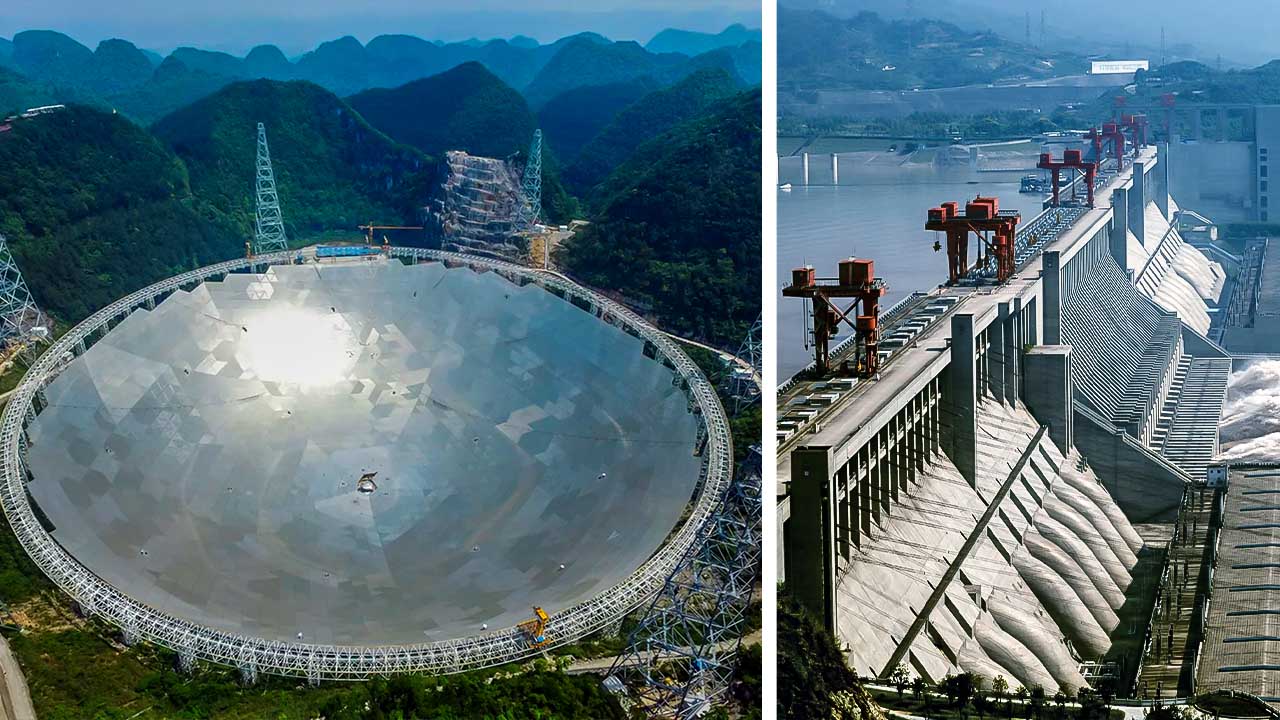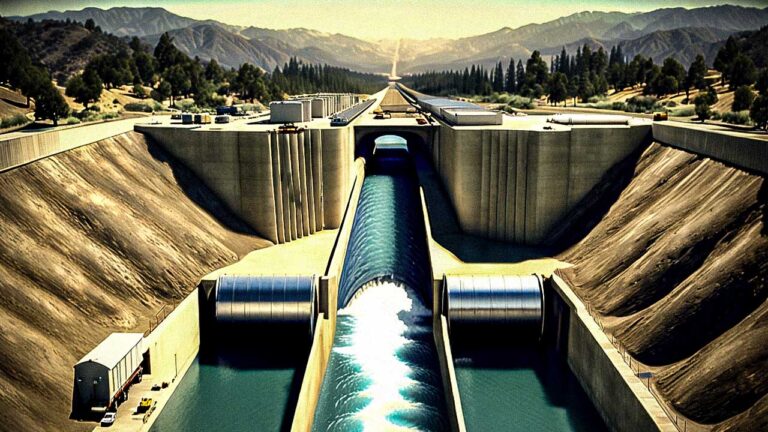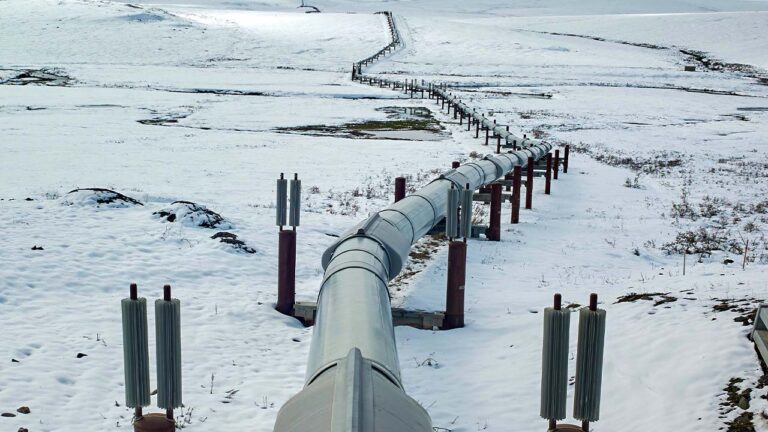Mind-Blowing Mega Projects in China You Need to See
China has been surprising the world with its mega construction projects and engineering innovations for the past few decades. From the world’s largest suspension bridges to energy projects, high-speed rail and space exploration, China has been refreshing its development. We also know that China’s such projects are not only competitive but also exemplary in durability, design, amenities and beauty.
The aim of such ambitious projects is the economic development of the country and the provision of facilities equipped with modern technology to the people. Such innovative and large-scale projects also provide vast employment opportunities that clearly help to improve the economic condition of the people, as China aims to settle 250 million people in the country’s rapidly developing megacities by 2026. In view of such a large number of migrants, various infrastructure improvement projects are underway in all regions of China.
It is certainly not possible to cover all of China’s infrastructure-related projects, because only during 2023, about 10,000 such construction projects have been launched in China, on which hundreds of billions of dollars are being spent.
Today, we will mention only a few such projects of China in 21st century which are considered incredible.
South–North Water Transfer Project
China suffers from various geographical problems due to its size. About 50% of its population lives in the north with a large portion of country’s industry, but these areas contain only 20% of China’s total water resources.
Keeping this fact in mind, the authorities have started a grand project to supply water from south to north. One route of this three-pronged water canal megaproject consisting of eastern route will reach Shanghai, while the central route will supply water to Beijing and the western route which brings water to northwestern China.
It is planned to complete this project by 2050, upon completion of which 44.8 billion cubic meters of water will be transported annually to meet the needs of the northern regions of the country.
Initially, the total cost of the project was estimated at $62 billion, which has reached $79 billion with the passage of time, but the benefits after its completion will surely be invaluable.
High Speed Railway Projects
The railway system has become a vital part of the modern economy, which is considered a sign of economic prosperity.
In October 2010, China won the honor of running the world’s fastest bullet train between Hangzhou and Shanghai, which recorded a speed of 413 km/h. With this bullet train, the journey of more than 2 hours between the two cities is completed in less than 45 minutes.
Just 2 years after this achievement, China inaugurated the longest high-speed railway line project between Beijing and Guangzhou for a distance of more than 2,100 km. This transformative development reduced the nearly 22-hour long train journey to just 8 hours.
Also Read: Gordie Howe Bridge Marks Milestone 2000 Days Into Construction
China wants to connect all its regions from the Gobi desert to the coldest city of Harbin by rail, and for this purpose, the work of laying tracks is going on even in the areas with the most severe weather conditions.
A railway line has even been laid to the new under construction city of Xiong’An, 100 km from Beijing, which is expected to be completed by 2035. In addition, in the beginning of 2022, China has also introduced the Fuxing bullet train, which has become the world’s first driverless bullet train.
Underwater Tunnel
To facilitate transportation, China has a wide network of roads and record-breaking high suspension bridges, but now various projects for underwater tunnels in the country are also being created and most of them are under construction.
These costly underwater tunnels are reducing travel time to a surprising extent.
Located near Shanghai in northeast China, Lake Taihu is the third largest natural reservoir of fresh water in the country, full of beautiful scenery and attracting tourists all year round.
Instead of a traditional bridge, an underwater tunnel has been planned to connect the two major cities on the shores of the lake namely Suzhou and Wuxi, so as to preserve the beauty of the lake.
Construction work on the 10.79 km long tunnel under the lake in Jiangsu Province, built at a cost of $1.56 billion, began on January 9, 2018. This six-lane, 17.45 meter-wide two-way tunnel connects the highways of Suzhou, Wuxi and Changzhou cities, resulting in a significant reduction in traffic congestion between Shanghai and Nanjing.
The roof is adorned with thousands of colorful LED lights, designed to keep the driver focused and reduce fatigue during long journeys in this straight tunnel. This nearly 11 km long Taihu Tunnel is the second longest road tunnel in the world after Norway’s Laerdal Tunnel.
The Highest Beipanjiang Bridge
China’s Beipanjiang Bridge can undoubtedly be called an engineering masterpiece. This suspension bridge, also known as the Duge Bridge, is an architectural marvel that connects the southern mountainous provinces of Guizhou and Yunnan.
This 4-lane 1.3 km long bridge is 565 meters high, surpassing San Francisco’s Golden Gate Bridge in height. New York’s Empire State Building can easily fit under this bridge. In addition to connecting the two provinces, the Beipanjiang Bridge has reduced the 4-hour journey to just a few moments.
This lofty bridge also reveals breathtaking views of the deep chasm that only a few count had seen before. At times, The Beipanjiang bridge is shrouded in clouds, giving travelers a dreamy atmosphere.
Gigantic Telescope
China has made significant progress in space exploration as well as other projects. It has also achieved significant success in this field by completing various missions step by step to know the secrets of the vastness of space. In an effort to touch the stars, China has developed the world’s largest radio telescope.
This modern telescope is named FAST, the Five-Hundred -meter Aperture Spherical radio Telescope, situated in southwest Guizhou province.
After the proposal of this mega telescope, more than 10 years were spent in choosing the best place to install it and finally a natural crater called Dawodang in Pingtang region of Guizhou was chosen.
The preparation of this megastructure was started in 2011 under the leadership of Chinese astronomer Nan Rentong, who said that for modern space research, it is necessary to build a radio telescope 20 times larger than the existing 25 meter diameter telescopes in China.
This telescope, which was completed in just 5 years, is also called the “China Sky Eye“, have identified more than 740 pulsars or neutron stars in the universe so far and this number is constantly increasing.
Guangzhou Evergrande Football Stadium
Despite any significant success in the field of football, the Chinese government has been actively working to promote this game. The development of the Evergrande Football Stadium in Guangzhou, a southwestern coastal city near Hong Kong, was started in April 2020.
Built in the shape of a lotus flower, the magnificent 1.6 million square feet stadium will have a capacity of 100,000 spectators, which is more than the Camp Nou stadium in Barcelona, Spain, which has a total capacity of 99,354.
Also Read: India’s First Bullet Train: The Mumbai–Ahmedabad High-Speed Rail Corridor
Initially, the construction cost of the stadium was estimated at $1.7 billion, and a deadline of December 2022 was set for its opening.
The completion of the megaproject was thrown into doubt when Evergrande Group announced in September 2021 that construction activities on the stadium would continue despite the liquidity crisis.
Speculations are currently circulating that the stadium will soon be auctioned, with potential buyers being sought. In the event that no private company is interested in completing the stadium, the project will be handed over to Quangzhou City Construction Investment Group.
Three Gorges Dam
Like some other countries in the world, China also has a few projects that have sparked controversy. One of them is the Three Gorges Dam built at a huge cost of over $31 billion.
An example of civil engineering, this project is considered to be the most powerful power station in the world, generating 75 to 115 TWh of electricity annually.
Despite its unique features, the Three Gorges Dam has also created a host of problems. An area of 1100 square kilometers was cleared for the lake of this dam, where the population of the area consisting of thousands of villages was 2 million people.
From the environmental point of view, it has had several negative consequences. Due to submergence of large areas for the lake and diversion of the river, many species of animals became extinct.
About 1,300 historical sites have also been submerged as a result of this massive project. But the most alarming impact is the geological changes caused by the dam.
Experts say that due to its immense size, the pressure on the Earth’s tectonic plates has increased, resulting in a significant increase in the number and intensity of earthquakes in the region, roughly 30 times more than before.
It is believed that due to the very high amount of concrete used in the construction of the dam, there are chances of the dam collapsing in the future.
These are just a few examples selected from the many large projects in China that have been built from 2000 to 2023. A number of mega projects are still under consideration in China, while work on a few construction projects is progressing rapidly. China is advancing step by step in the world of modern technology, which is a prime example of its dedication to development.







